Leadership, Ethics, and Culture: A Case Study of Enron's Downfall
VerifiedAdded on 2020/05/11
|13
|3228
|31
Report
AI Summary
This report provides an in-depth analysis of the Enron scandal, focusing on the critical role of leadership in shaping organizational culture and ethical conduct. The report begins with an executive summary outlining the key issues, including a lack of transparency, unethical executive behavior, and the involvement of an unethical accounting firm. It explores leadership theories such as Trait Theory and Contingency Theory, examining how they apply to Enron's situation. The report then investigates how leadership can influence organizational culture, emphasizing the importance of leaders acting as role models, defining the purpose behind decisions, and promoting accountability. The analysis highlights the ways in which Enron's leadership failed to positively influence its culture, leading to widespread unethical practices. Finally, the report offers recommendations to curb unethical behavior and promote ethical practices within organizations, emphasizing the importance of integrity, transparency, and accountability in leadership. The case study underscores the profound impact of leadership on an organization's success and ethical standing.
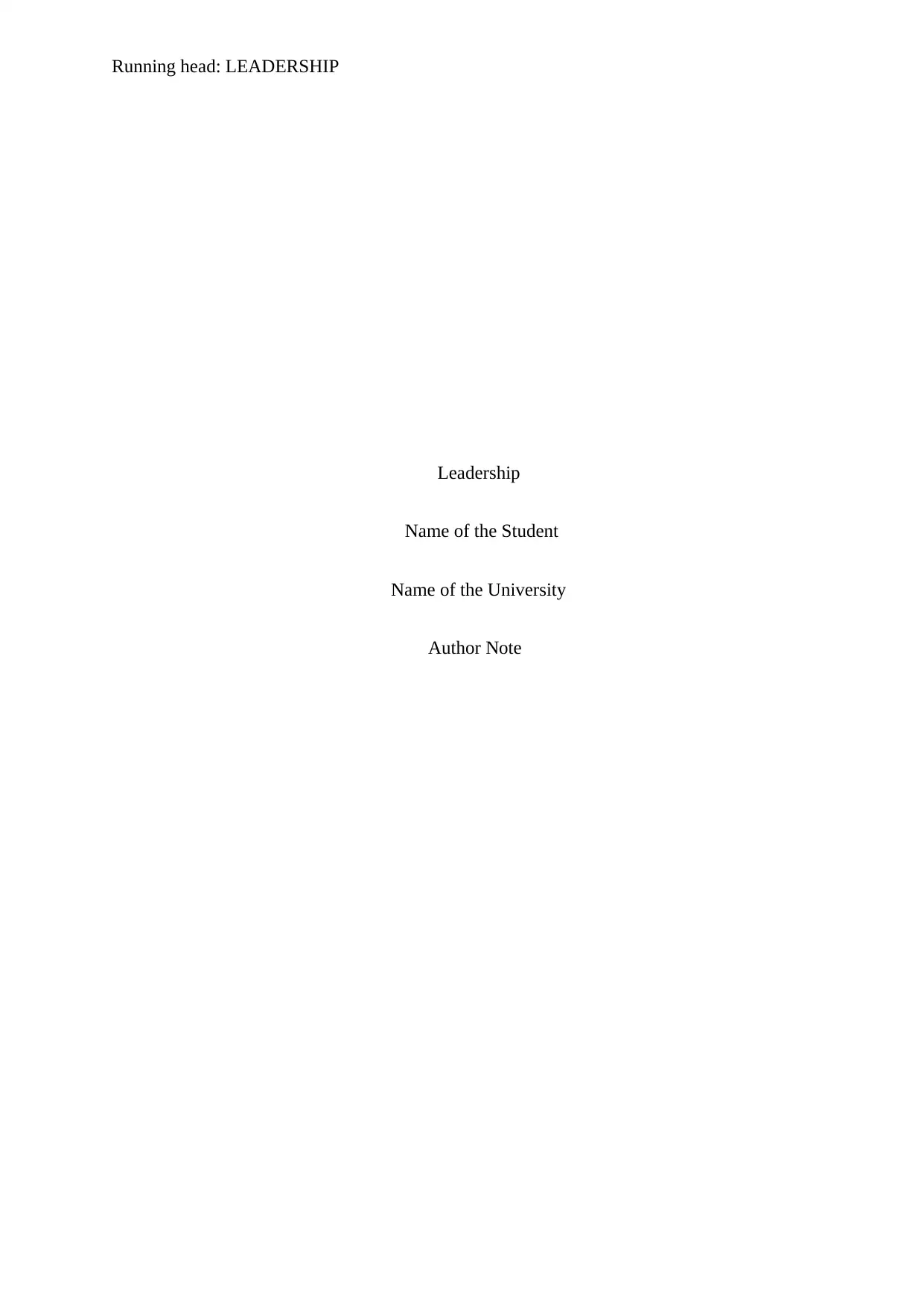
Running head: LEADERSHIP
Leadership
Name of the Student
Name of the University
Author Note
Leadership
Name of the Student
Name of the University
Author Note
Paraphrase This Document
Need a fresh take? Get an instant paraphrase of this document with our AI Paraphraser
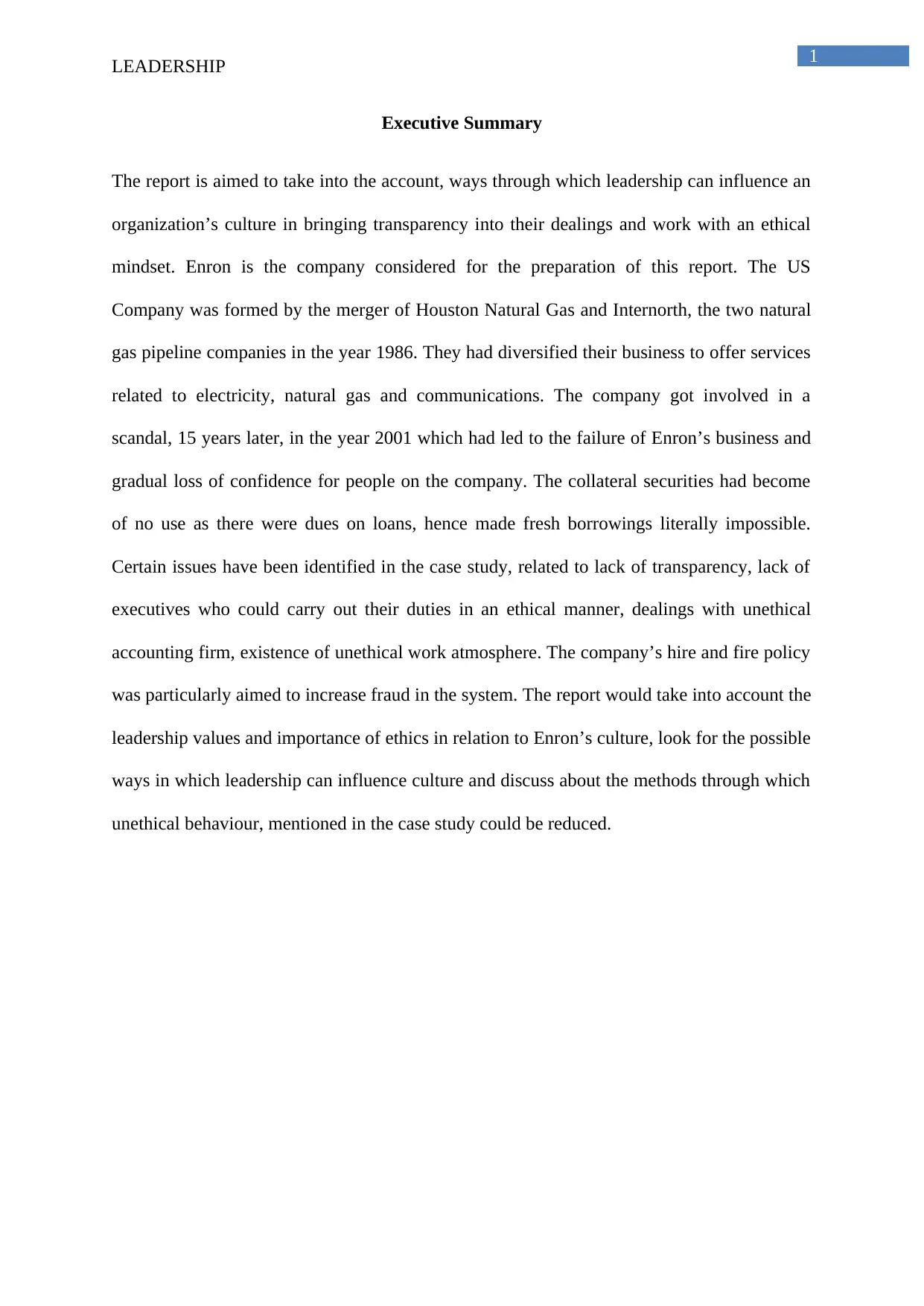
1
LEADERSHIP
Executive Summary
The report is aimed to take into the account, ways through which leadership can influence an
organization’s culture in bringing transparency into their dealings and work with an ethical
mindset. Enron is the company considered for the preparation of this report. The US
Company was formed by the merger of Houston Natural Gas and Internorth, the two natural
gas pipeline companies in the year 1986. They had diversified their business to offer services
related to electricity, natural gas and communications. The company got involved in a
scandal, 15 years later, in the year 2001 which had led to the failure of Enron’s business and
gradual loss of confidence for people on the company. The collateral securities had become
of no use as there were dues on loans, hence made fresh borrowings literally impossible.
Certain issues have been identified in the case study, related to lack of transparency, lack of
executives who could carry out their duties in an ethical manner, dealings with unethical
accounting firm, existence of unethical work atmosphere. The company’s hire and fire policy
was particularly aimed to increase fraud in the system. The report would take into account the
leadership values and importance of ethics in relation to Enron’s culture, look for the possible
ways in which leadership can influence culture and discuss about the methods through which
unethical behaviour, mentioned in the case study could be reduced.
LEADERSHIP
Executive Summary
The report is aimed to take into the account, ways through which leadership can influence an
organization’s culture in bringing transparency into their dealings and work with an ethical
mindset. Enron is the company considered for the preparation of this report. The US
Company was formed by the merger of Houston Natural Gas and Internorth, the two natural
gas pipeline companies in the year 1986. They had diversified their business to offer services
related to electricity, natural gas and communications. The company got involved in a
scandal, 15 years later, in the year 2001 which had led to the failure of Enron’s business and
gradual loss of confidence for people on the company. The collateral securities had become
of no use as there were dues on loans, hence made fresh borrowings literally impossible.
Certain issues have been identified in the case study, related to lack of transparency, lack of
executives who could carry out their duties in an ethical manner, dealings with unethical
accounting firm, existence of unethical work atmosphere. The company’s hire and fire policy
was particularly aimed to increase fraud in the system. The report would take into account the
leadership values and importance of ethics in relation to Enron’s culture, look for the possible
ways in which leadership can influence culture and discuss about the methods through which
unethical behaviour, mentioned in the case study could be reduced.
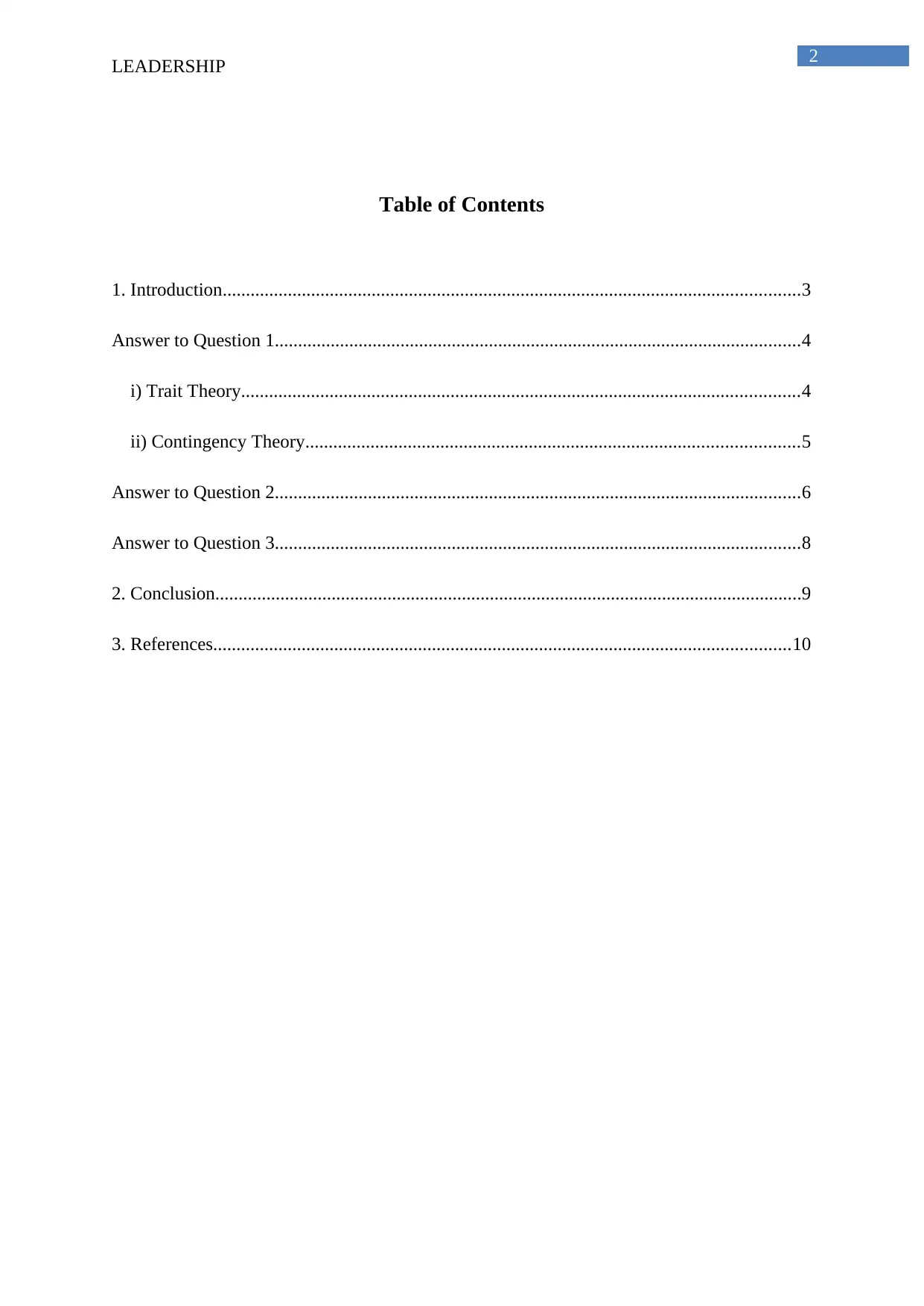
2
LEADERSHIP
Table of Contents
1. Introduction............................................................................................................................3
Answer to Question 1.................................................................................................................4
i) Trait Theory........................................................................................................................4
ii) Contingency Theory..........................................................................................................5
Answer to Question 2.................................................................................................................6
Answer to Question 3.................................................................................................................8
2. Conclusion..............................................................................................................................9
3. References............................................................................................................................10
LEADERSHIP
Table of Contents
1. Introduction............................................................................................................................3
Answer to Question 1.................................................................................................................4
i) Trait Theory........................................................................................................................4
ii) Contingency Theory..........................................................................................................5
Answer to Question 2.................................................................................................................6
Answer to Question 3.................................................................................................................8
2. Conclusion..............................................................................................................................9
3. References............................................................................................................................10
⊘ This is a preview!⊘
Do you want full access?
Subscribe today to unlock all pages.

Trusted by 1+ million students worldwide
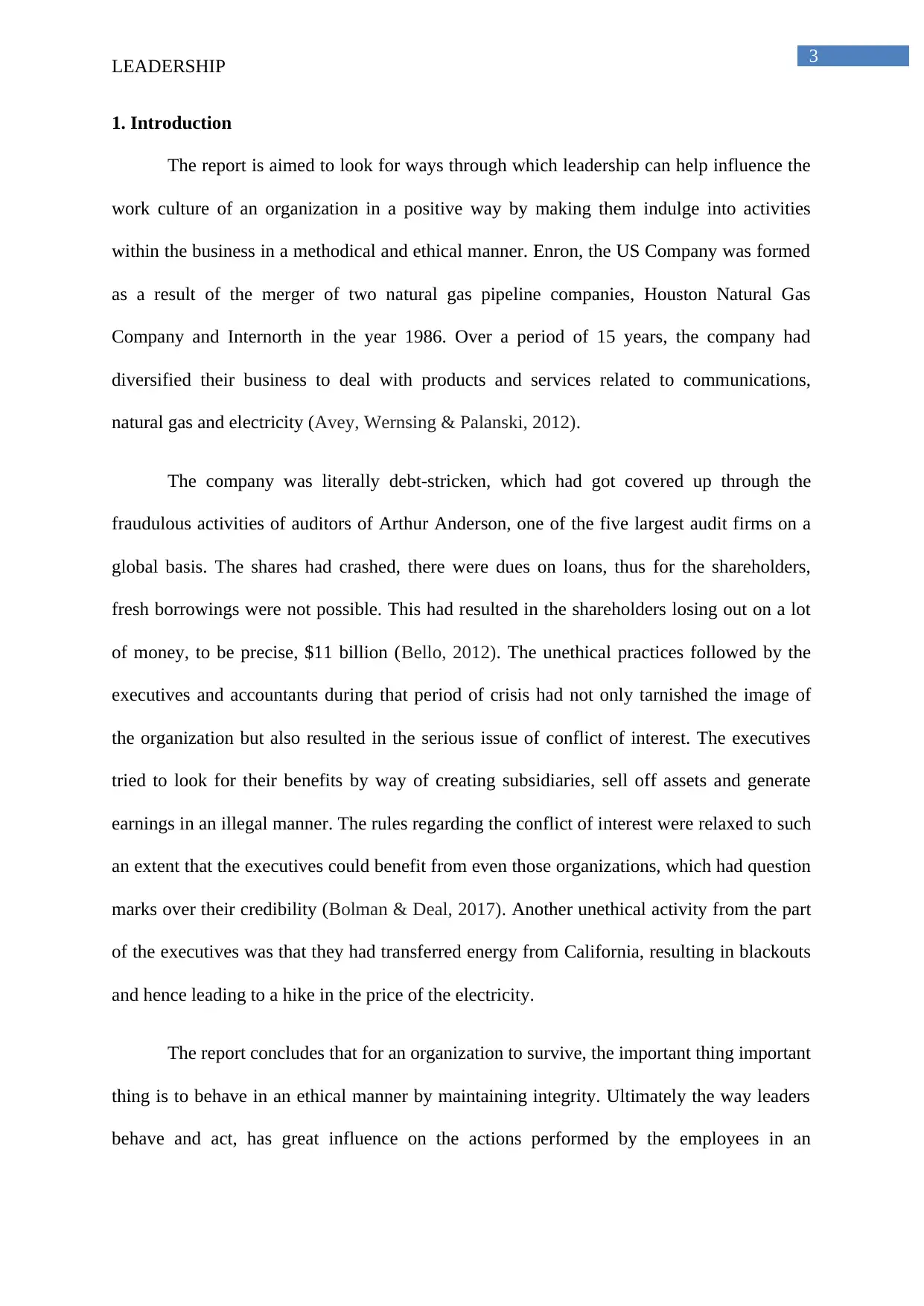
3
LEADERSHIP
1. Introduction
The report is aimed to look for ways through which leadership can help influence the
work culture of an organization in a positive way by making them indulge into activities
within the business in a methodical and ethical manner. Enron, the US Company was formed
as a result of the merger of two natural gas pipeline companies, Houston Natural Gas
Company and Internorth in the year 1986. Over a period of 15 years, the company had
diversified their business to deal with products and services related to communications,
natural gas and electricity (Avey, Wernsing & Palanski, 2012).
The company was literally debt-stricken, which had got covered up through the
fraudulous activities of auditors of Arthur Anderson, one of the five largest audit firms on a
global basis. The shares had crashed, there were dues on loans, thus for the shareholders,
fresh borrowings were not possible. This had resulted in the shareholders losing out on a lot
of money, to be precise, $11 billion (Bello, 2012). The unethical practices followed by the
executives and accountants during that period of crisis had not only tarnished the image of
the organization but also resulted in the serious issue of conflict of interest. The executives
tried to look for their benefits by way of creating subsidiaries, sell off assets and generate
earnings in an illegal manner. The rules regarding the conflict of interest were relaxed to such
an extent that the executives could benefit from even those organizations, which had question
marks over their credibility (Bolman & Deal, 2017). Another unethical activity from the part
of the executives was that they had transferred energy from California, resulting in blackouts
and hence leading to a hike in the price of the electricity.
The report concludes that for an organization to survive, the important thing important
thing is to behave in an ethical manner by maintaining integrity. Ultimately the way leaders
behave and act, has great influence on the actions performed by the employees in an
LEADERSHIP
1. Introduction
The report is aimed to look for ways through which leadership can help influence the
work culture of an organization in a positive way by making them indulge into activities
within the business in a methodical and ethical manner. Enron, the US Company was formed
as a result of the merger of two natural gas pipeline companies, Houston Natural Gas
Company and Internorth in the year 1986. Over a period of 15 years, the company had
diversified their business to deal with products and services related to communications,
natural gas and electricity (Avey, Wernsing & Palanski, 2012).
The company was literally debt-stricken, which had got covered up through the
fraudulous activities of auditors of Arthur Anderson, one of the five largest audit firms on a
global basis. The shares had crashed, there were dues on loans, thus for the shareholders,
fresh borrowings were not possible. This had resulted in the shareholders losing out on a lot
of money, to be precise, $11 billion (Bello, 2012). The unethical practices followed by the
executives and accountants during that period of crisis had not only tarnished the image of
the organization but also resulted in the serious issue of conflict of interest. The executives
tried to look for their benefits by way of creating subsidiaries, sell off assets and generate
earnings in an illegal manner. The rules regarding the conflict of interest were relaxed to such
an extent that the executives could benefit from even those organizations, which had question
marks over their credibility (Bolman & Deal, 2017). Another unethical activity from the part
of the executives was that they had transferred energy from California, resulting in blackouts
and hence leading to a hike in the price of the electricity.
The report concludes that for an organization to survive, the important thing important
thing is to behave in an ethical manner by maintaining integrity. Ultimately the way leaders
behave and act, has great influence on the actions performed by the employees in an
Paraphrase This Document
Need a fresh take? Get an instant paraphrase of this document with our AI Paraphraser
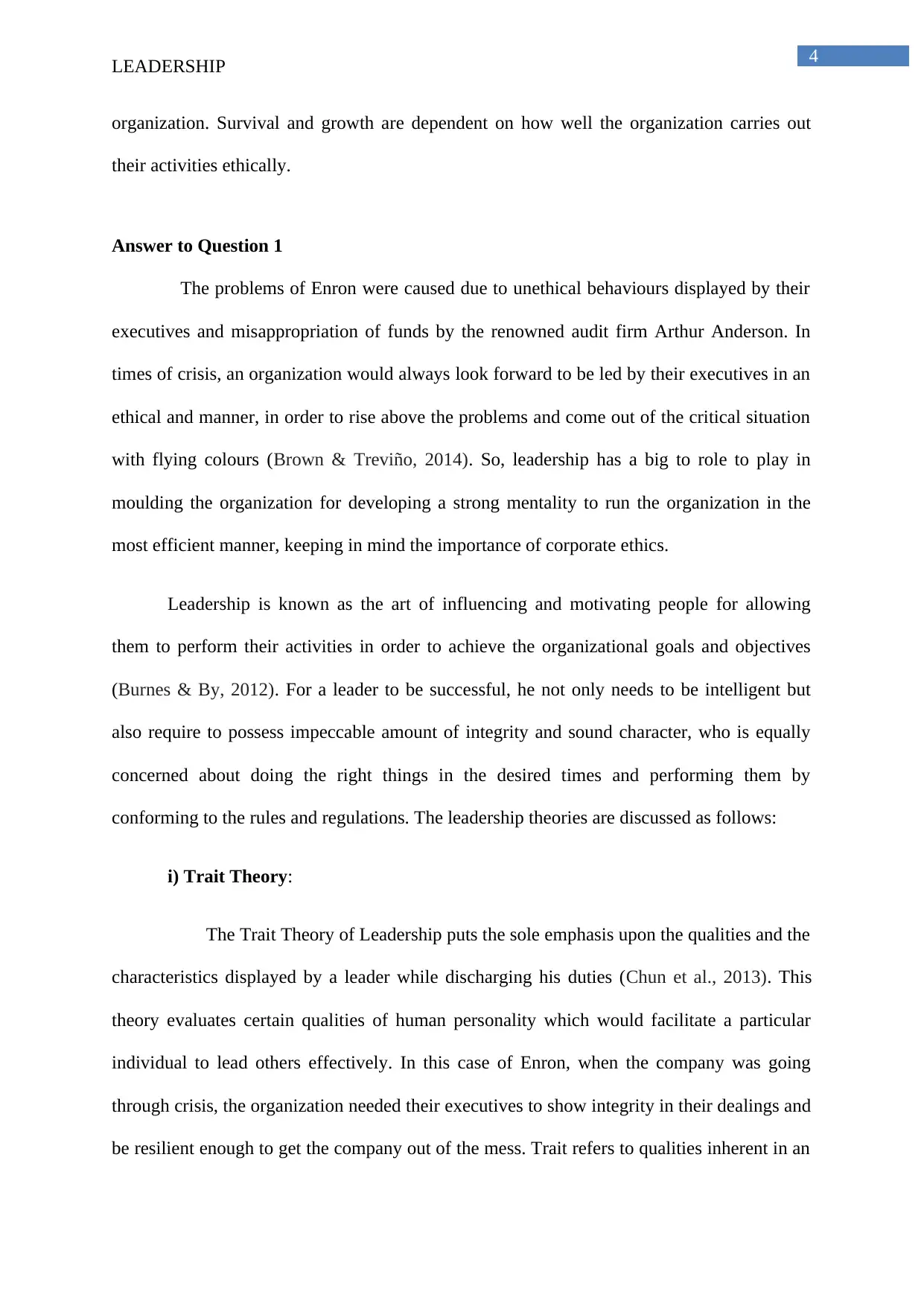
4
LEADERSHIP
organization. Survival and growth are dependent on how well the organization carries out
their activities ethically.
Answer to Question 1
The problems of Enron were caused due to unethical behaviours displayed by their
executives and misappropriation of funds by the renowned audit firm Arthur Anderson. In
times of crisis, an organization would always look forward to be led by their executives in an
ethical and manner, in order to rise above the problems and come out of the critical situation
with flying colours (Brown & Treviño, 2014). So, leadership has a big to role to play in
moulding the organization for developing a strong mentality to run the organization in the
most efficient manner, keeping in mind the importance of corporate ethics.
Leadership is known as the art of influencing and motivating people for allowing
them to perform their activities in order to achieve the organizational goals and objectives
(Burnes & By, 2012). For a leader to be successful, he not only needs to be intelligent but
also require to possess impeccable amount of integrity and sound character, who is equally
concerned about doing the right things in the desired times and performing them by
conforming to the rules and regulations. The leadership theories are discussed as follows:
i) Trait Theory:
The Trait Theory of Leadership puts the sole emphasis upon the qualities and the
characteristics displayed by a leader while discharging his duties (Chun et al., 2013). This
theory evaluates certain qualities of human personality which would facilitate a particular
individual to lead others effectively. In this case of Enron, when the company was going
through crisis, the organization needed their executives to show integrity in their dealings and
be resilient enough to get the company out of the mess. Trait refers to qualities inherent in an
LEADERSHIP
organization. Survival and growth are dependent on how well the organization carries out
their activities ethically.
Answer to Question 1
The problems of Enron were caused due to unethical behaviours displayed by their
executives and misappropriation of funds by the renowned audit firm Arthur Anderson. In
times of crisis, an organization would always look forward to be led by their executives in an
ethical and manner, in order to rise above the problems and come out of the critical situation
with flying colours (Brown & Treviño, 2014). So, leadership has a big to role to play in
moulding the organization for developing a strong mentality to run the organization in the
most efficient manner, keeping in mind the importance of corporate ethics.
Leadership is known as the art of influencing and motivating people for allowing
them to perform their activities in order to achieve the organizational goals and objectives
(Burnes & By, 2012). For a leader to be successful, he not only needs to be intelligent but
also require to possess impeccable amount of integrity and sound character, who is equally
concerned about doing the right things in the desired times and performing them by
conforming to the rules and regulations. The leadership theories are discussed as follows:
i) Trait Theory:
The Trait Theory of Leadership puts the sole emphasis upon the qualities and the
characteristics displayed by a leader while discharging his duties (Chun et al., 2013). This
theory evaluates certain qualities of human personality which would facilitate a particular
individual to lead others effectively. In this case of Enron, when the company was going
through crisis, the organization needed their executives to show integrity in their dealings and
be resilient enough to get the company out of the mess. Trait refers to qualities inherent in an
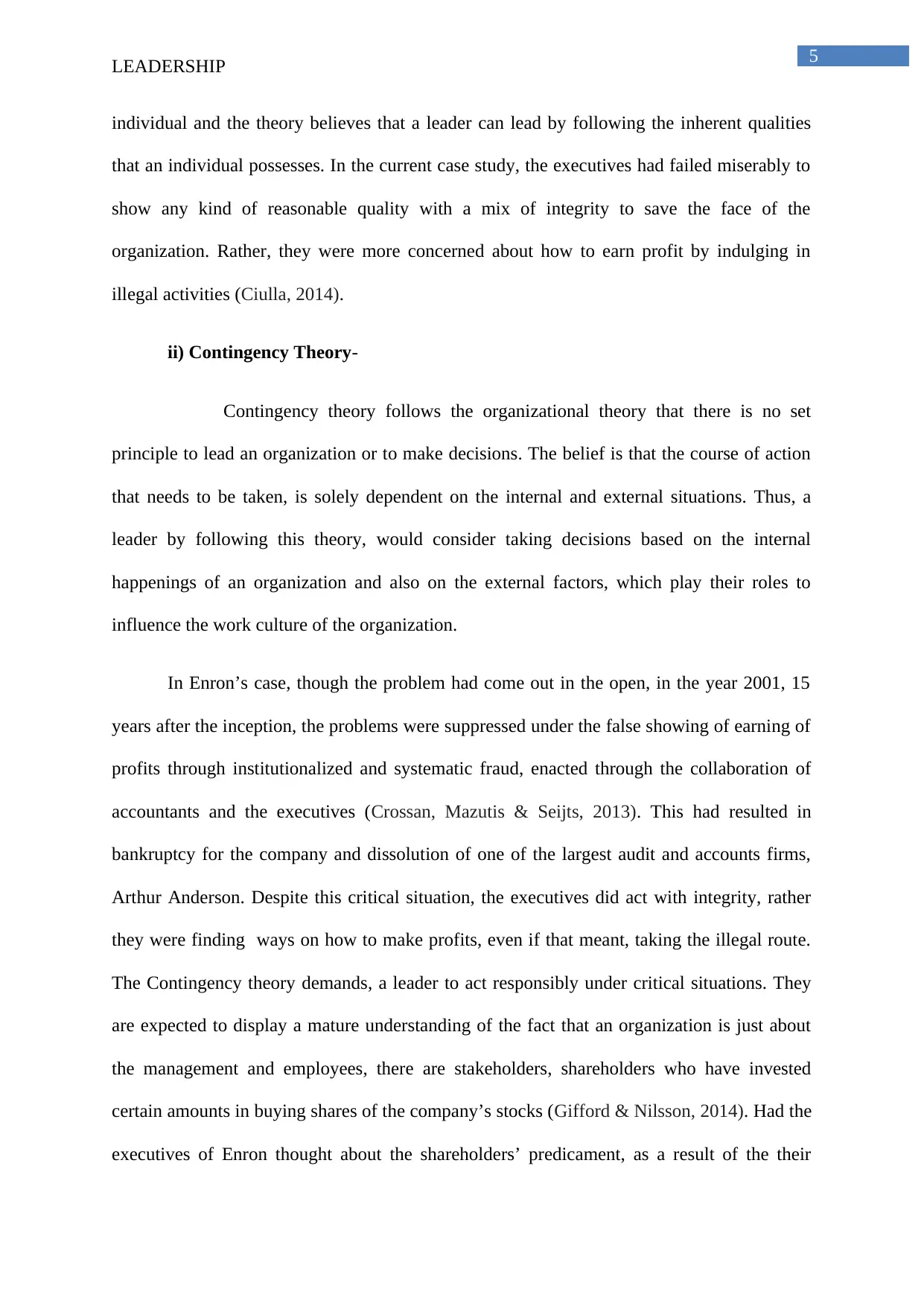
5
LEADERSHIP
individual and the theory believes that a leader can lead by following the inherent qualities
that an individual possesses. In the current case study, the executives had failed miserably to
show any kind of reasonable quality with a mix of integrity to save the face of the
organization. Rather, they were more concerned about how to earn profit by indulging in
illegal activities (Ciulla, 2014).
ii) Contingency Theory-
Contingency theory follows the organizational theory that there is no set
principle to lead an organization or to make decisions. The belief is that the course of action
that needs to be taken, is solely dependent on the internal and external situations. Thus, a
leader by following this theory, would consider taking decisions based on the internal
happenings of an organization and also on the external factors, which play their roles to
influence the work culture of the organization.
In Enron’s case, though the problem had come out in the open, in the year 2001, 15
years after the inception, the problems were suppressed under the false showing of earning of
profits through institutionalized and systematic fraud, enacted through the collaboration of
accountants and the executives (Crossan, Mazutis & Seijts, 2013). This had resulted in
bankruptcy for the company and dissolution of one of the largest audit and accounts firms,
Arthur Anderson. Despite this critical situation, the executives did act with integrity, rather
they were finding ways on how to make profits, even if that meant, taking the illegal route.
The Contingency theory demands, a leader to act responsibly under critical situations. They
are expected to display a mature understanding of the fact that an organization is just about
the management and employees, there are stakeholders, shareholders who have invested
certain amounts in buying shares of the company’s stocks (Gifford & Nilsson, 2014). Had the
executives of Enron thought about the shareholders’ predicament, as a result of the their
LEADERSHIP
individual and the theory believes that a leader can lead by following the inherent qualities
that an individual possesses. In the current case study, the executives had failed miserably to
show any kind of reasonable quality with a mix of integrity to save the face of the
organization. Rather, they were more concerned about how to earn profit by indulging in
illegal activities (Ciulla, 2014).
ii) Contingency Theory-
Contingency theory follows the organizational theory that there is no set
principle to lead an organization or to make decisions. The belief is that the course of action
that needs to be taken, is solely dependent on the internal and external situations. Thus, a
leader by following this theory, would consider taking decisions based on the internal
happenings of an organization and also on the external factors, which play their roles to
influence the work culture of the organization.
In Enron’s case, though the problem had come out in the open, in the year 2001, 15
years after the inception, the problems were suppressed under the false showing of earning of
profits through institutionalized and systematic fraud, enacted through the collaboration of
accountants and the executives (Crossan, Mazutis & Seijts, 2013). This had resulted in
bankruptcy for the company and dissolution of one of the largest audit and accounts firms,
Arthur Anderson. Despite this critical situation, the executives did act with integrity, rather
they were finding ways on how to make profits, even if that meant, taking the illegal route.
The Contingency theory demands, a leader to act responsibly under critical situations. They
are expected to display a mature understanding of the fact that an organization is just about
the management and employees, there are stakeholders, shareholders who have invested
certain amounts in buying shares of the company’s stocks (Gifford & Nilsson, 2014). Had the
executives of Enron thought about the shareholders’ predicament, as a result of the their
⊘ This is a preview!⊘
Do you want full access?
Subscribe today to unlock all pages.

Trusted by 1+ million students worldwide
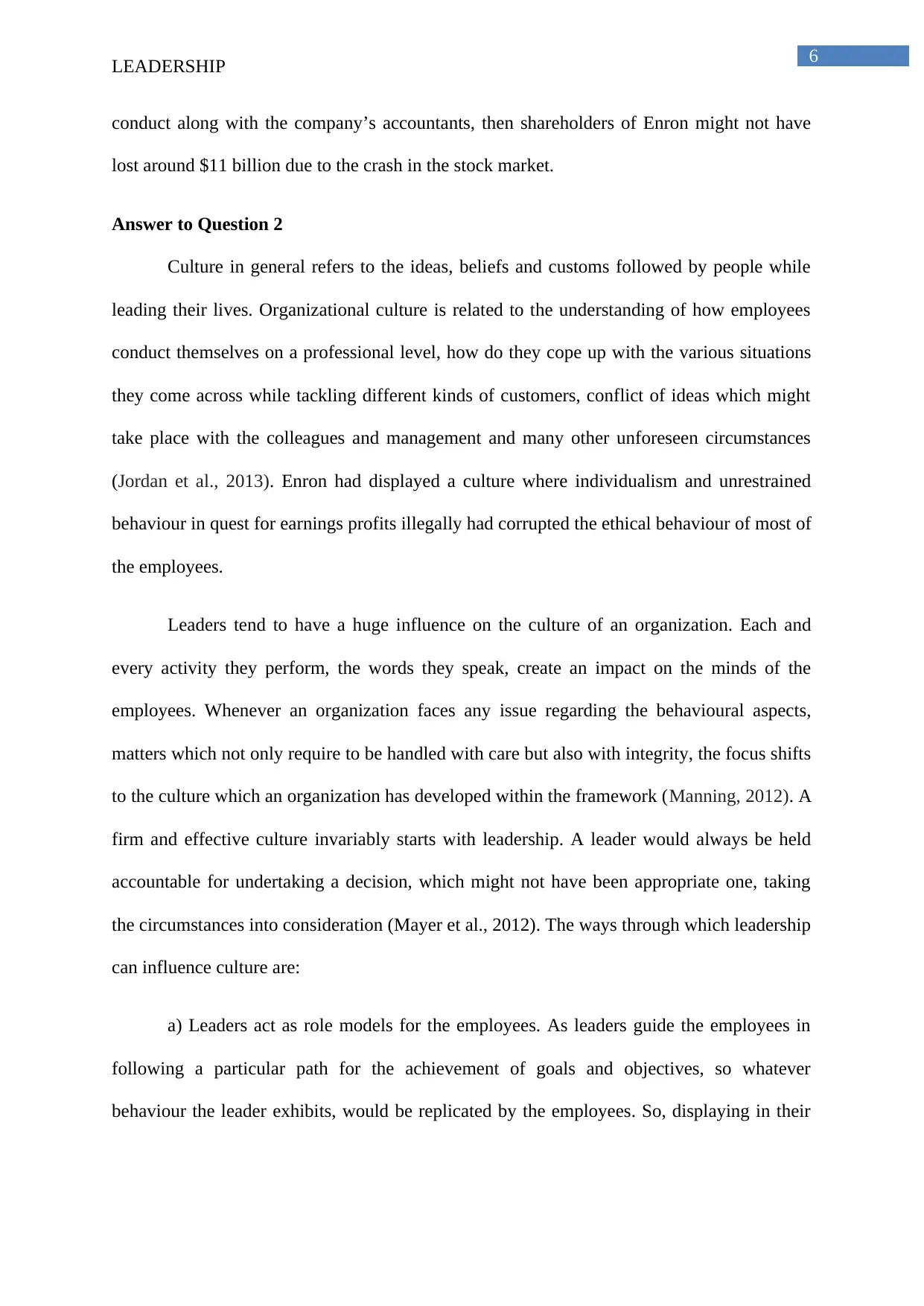
6
LEADERSHIP
conduct along with the company’s accountants, then shareholders of Enron might not have
lost around $11 billion due to the crash in the stock market.
Answer to Question 2
Culture in general refers to the ideas, beliefs and customs followed by people while
leading their lives. Organizational culture is related to the understanding of how employees
conduct themselves on a professional level, how do they cope up with the various situations
they come across while tackling different kinds of customers, conflict of ideas which might
take place with the colleagues and management and many other unforeseen circumstances
(Jordan et al., 2013). Enron had displayed a culture where individualism and unrestrained
behaviour in quest for earnings profits illegally had corrupted the ethical behaviour of most of
the employees.
Leaders tend to have a huge influence on the culture of an organization. Each and
every activity they perform, the words they speak, create an impact on the minds of the
employees. Whenever an organization faces any issue regarding the behavioural aspects,
matters which not only require to be handled with care but also with integrity, the focus shifts
to the culture which an organization has developed within the framework (Manning, 2012). A
firm and effective culture invariably starts with leadership. A leader would always be held
accountable for undertaking a decision, which might not have been appropriate one, taking
the circumstances into consideration (Mayer et al., 2012). The ways through which leadership
can influence culture are:
a) Leaders act as role models for the employees. As leaders guide the employees in
following a particular path for the achievement of goals and objectives, so whatever
behaviour the leader exhibits, would be replicated by the employees. So, displaying in their
LEADERSHIP
conduct along with the company’s accountants, then shareholders of Enron might not have
lost around $11 billion due to the crash in the stock market.
Answer to Question 2
Culture in general refers to the ideas, beliefs and customs followed by people while
leading their lives. Organizational culture is related to the understanding of how employees
conduct themselves on a professional level, how do they cope up with the various situations
they come across while tackling different kinds of customers, conflict of ideas which might
take place with the colleagues and management and many other unforeseen circumstances
(Jordan et al., 2013). Enron had displayed a culture where individualism and unrestrained
behaviour in quest for earnings profits illegally had corrupted the ethical behaviour of most of
the employees.
Leaders tend to have a huge influence on the culture of an organization. Each and
every activity they perform, the words they speak, create an impact on the minds of the
employees. Whenever an organization faces any issue regarding the behavioural aspects,
matters which not only require to be handled with care but also with integrity, the focus shifts
to the culture which an organization has developed within the framework (Manning, 2012). A
firm and effective culture invariably starts with leadership. A leader would always be held
accountable for undertaking a decision, which might not have been appropriate one, taking
the circumstances into consideration (Mayer et al., 2012). The ways through which leadership
can influence culture are:
a) Leaders act as role models for the employees. As leaders guide the employees in
following a particular path for the achievement of goals and objectives, so whatever
behaviour the leader exhibits, would be replicated by the employees. So, displaying in their
Paraphrase This Document
Need a fresh take? Get an instant paraphrase of this document with our AI Paraphraser
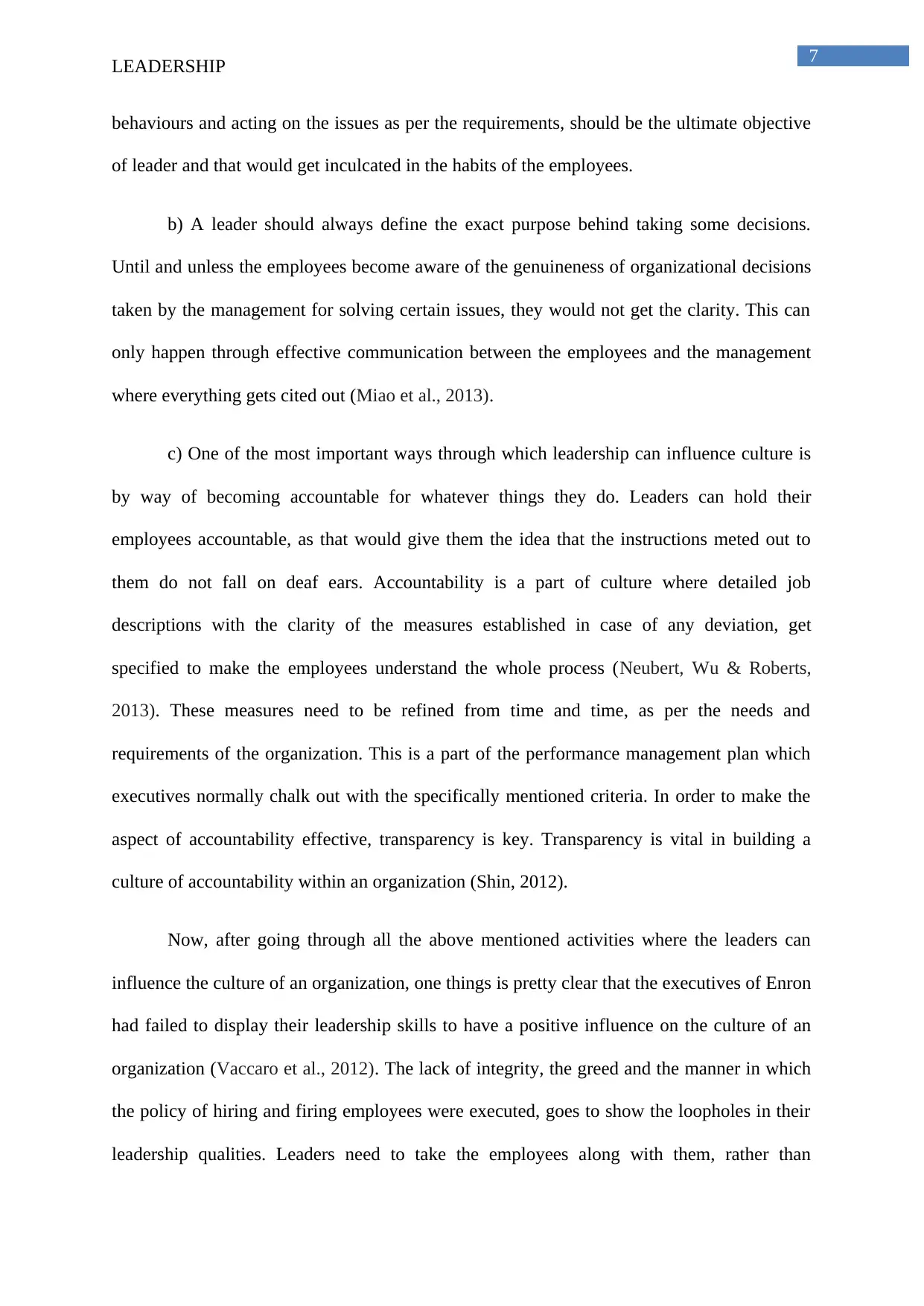
7
LEADERSHIP
behaviours and acting on the issues as per the requirements, should be the ultimate objective
of leader and that would get inculcated in the habits of the employees.
b) A leader should always define the exact purpose behind taking some decisions.
Until and unless the employees become aware of the genuineness of organizational decisions
taken by the management for solving certain issues, they would not get the clarity. This can
only happen through effective communication between the employees and the management
where everything gets cited out (Miao et al., 2013).
c) One of the most important ways through which leadership can influence culture is
by way of becoming accountable for whatever things they do. Leaders can hold their
employees accountable, as that would give them the idea that the instructions meted out to
them do not fall on deaf ears. Accountability is a part of culture where detailed job
descriptions with the clarity of the measures established in case of any deviation, get
specified to make the employees understand the whole process (Neubert, Wu & Roberts,
2013). These measures need to be refined from time and time, as per the needs and
requirements of the organization. This is a part of the performance management plan which
executives normally chalk out with the specifically mentioned criteria. In order to make the
aspect of accountability effective, transparency is key. Transparency is vital in building a
culture of accountability within an organization (Shin, 2012).
Now, after going through all the above mentioned activities where the leaders can
influence the culture of an organization, one things is pretty clear that the executives of Enron
had failed to display their leadership skills to have a positive influence on the culture of an
organization (Vaccaro et al., 2012). The lack of integrity, the greed and the manner in which
the policy of hiring and firing employees were executed, goes to show the loopholes in their
leadership qualities. Leaders need to take the employees along with them, rather than
LEADERSHIP
behaviours and acting on the issues as per the requirements, should be the ultimate objective
of leader and that would get inculcated in the habits of the employees.
b) A leader should always define the exact purpose behind taking some decisions.
Until and unless the employees become aware of the genuineness of organizational decisions
taken by the management for solving certain issues, they would not get the clarity. This can
only happen through effective communication between the employees and the management
where everything gets cited out (Miao et al., 2013).
c) One of the most important ways through which leadership can influence culture is
by way of becoming accountable for whatever things they do. Leaders can hold their
employees accountable, as that would give them the idea that the instructions meted out to
them do not fall on deaf ears. Accountability is a part of culture where detailed job
descriptions with the clarity of the measures established in case of any deviation, get
specified to make the employees understand the whole process (Neubert, Wu & Roberts,
2013). These measures need to be refined from time and time, as per the needs and
requirements of the organization. This is a part of the performance management plan which
executives normally chalk out with the specifically mentioned criteria. In order to make the
aspect of accountability effective, transparency is key. Transparency is vital in building a
culture of accountability within an organization (Shin, 2012).
Now, after going through all the above mentioned activities where the leaders can
influence the culture of an organization, one things is pretty clear that the executives of Enron
had failed to display their leadership skills to have a positive influence on the culture of an
organization (Vaccaro et al., 2012). The lack of integrity, the greed and the manner in which
the policy of hiring and firing employees were executed, goes to show the loopholes in their
leadership qualities. Leaders need to take the employees along with them, rather than
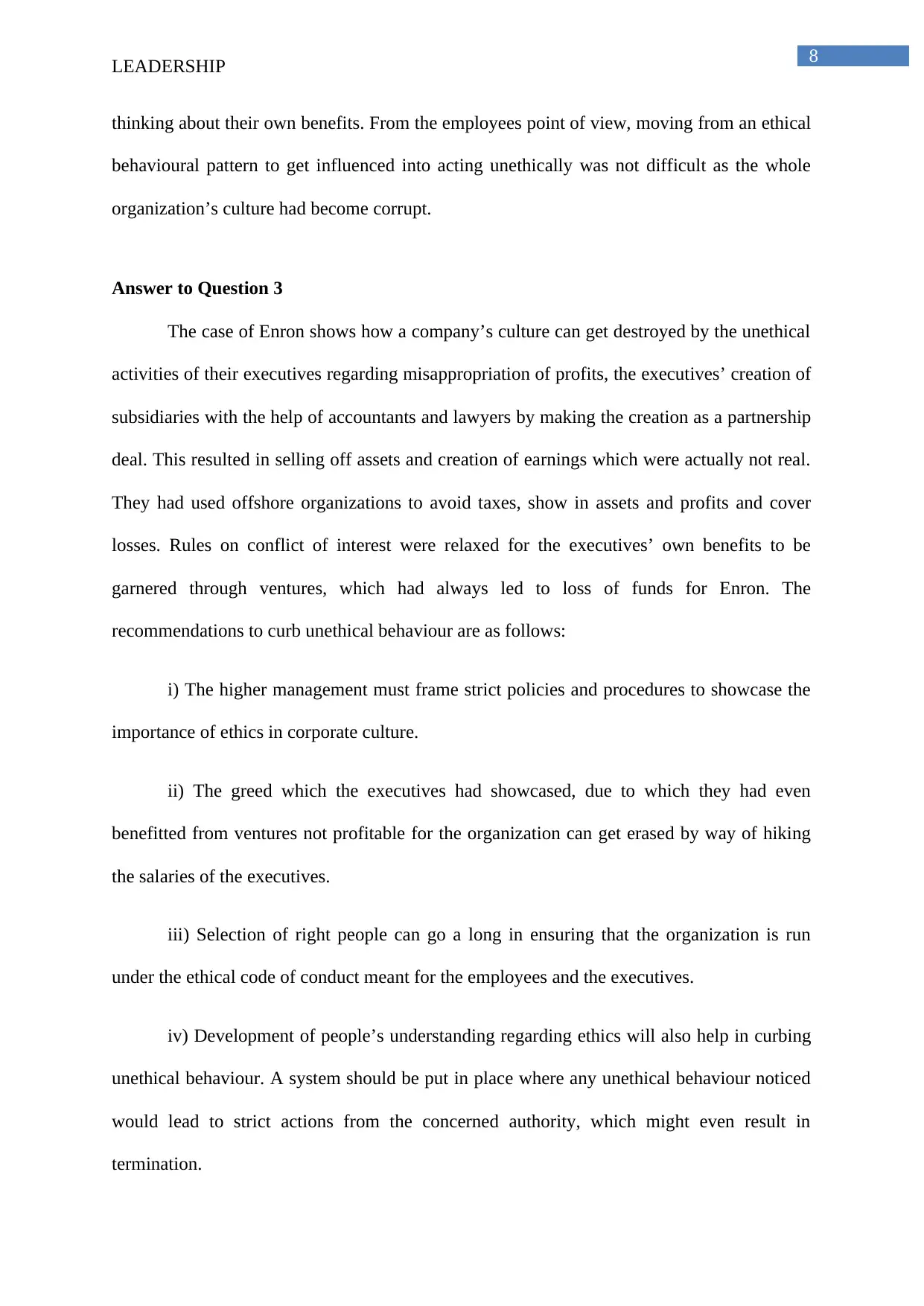
8
LEADERSHIP
thinking about their own benefits. From the employees point of view, moving from an ethical
behavioural pattern to get influenced into acting unethically was not difficult as the whole
organization’s culture had become corrupt.
Answer to Question 3
The case of Enron shows how a company’s culture can get destroyed by the unethical
activities of their executives regarding misappropriation of profits, the executives’ creation of
subsidiaries with the help of accountants and lawyers by making the creation as a partnership
deal. This resulted in selling off assets and creation of earnings which were actually not real.
They had used offshore organizations to avoid taxes, show in assets and profits and cover
losses. Rules on conflict of interest were relaxed for the executives’ own benefits to be
garnered through ventures, which had always led to loss of funds for Enron. The
recommendations to curb unethical behaviour are as follows:
i) The higher management must frame strict policies and procedures to showcase the
importance of ethics in corporate culture.
ii) The greed which the executives had showcased, due to which they had even
benefitted from ventures not profitable for the organization can get erased by way of hiking
the salaries of the executives.
iii) Selection of right people can go a long in ensuring that the organization is run
under the ethical code of conduct meant for the employees and the executives.
iv) Development of people’s understanding regarding ethics will also help in curbing
unethical behaviour. A system should be put in place where any unethical behaviour noticed
would lead to strict actions from the concerned authority, which might even result in
termination.
LEADERSHIP
thinking about their own benefits. From the employees point of view, moving from an ethical
behavioural pattern to get influenced into acting unethically was not difficult as the whole
organization’s culture had become corrupt.
Answer to Question 3
The case of Enron shows how a company’s culture can get destroyed by the unethical
activities of their executives regarding misappropriation of profits, the executives’ creation of
subsidiaries with the help of accountants and lawyers by making the creation as a partnership
deal. This resulted in selling off assets and creation of earnings which were actually not real.
They had used offshore organizations to avoid taxes, show in assets and profits and cover
losses. Rules on conflict of interest were relaxed for the executives’ own benefits to be
garnered through ventures, which had always led to loss of funds for Enron. The
recommendations to curb unethical behaviour are as follows:
i) The higher management must frame strict policies and procedures to showcase the
importance of ethics in corporate culture.
ii) The greed which the executives had showcased, due to which they had even
benefitted from ventures not profitable for the organization can get erased by way of hiking
the salaries of the executives.
iii) Selection of right people can go a long in ensuring that the organization is run
under the ethical code of conduct meant for the employees and the executives.
iv) Development of people’s understanding regarding ethics will also help in curbing
unethical behaviour. A system should be put in place where any unethical behaviour noticed
would lead to strict actions from the concerned authority, which might even result in
termination.
⊘ This is a preview!⊘
Do you want full access?
Subscribe today to unlock all pages.

Trusted by 1+ million students worldwide
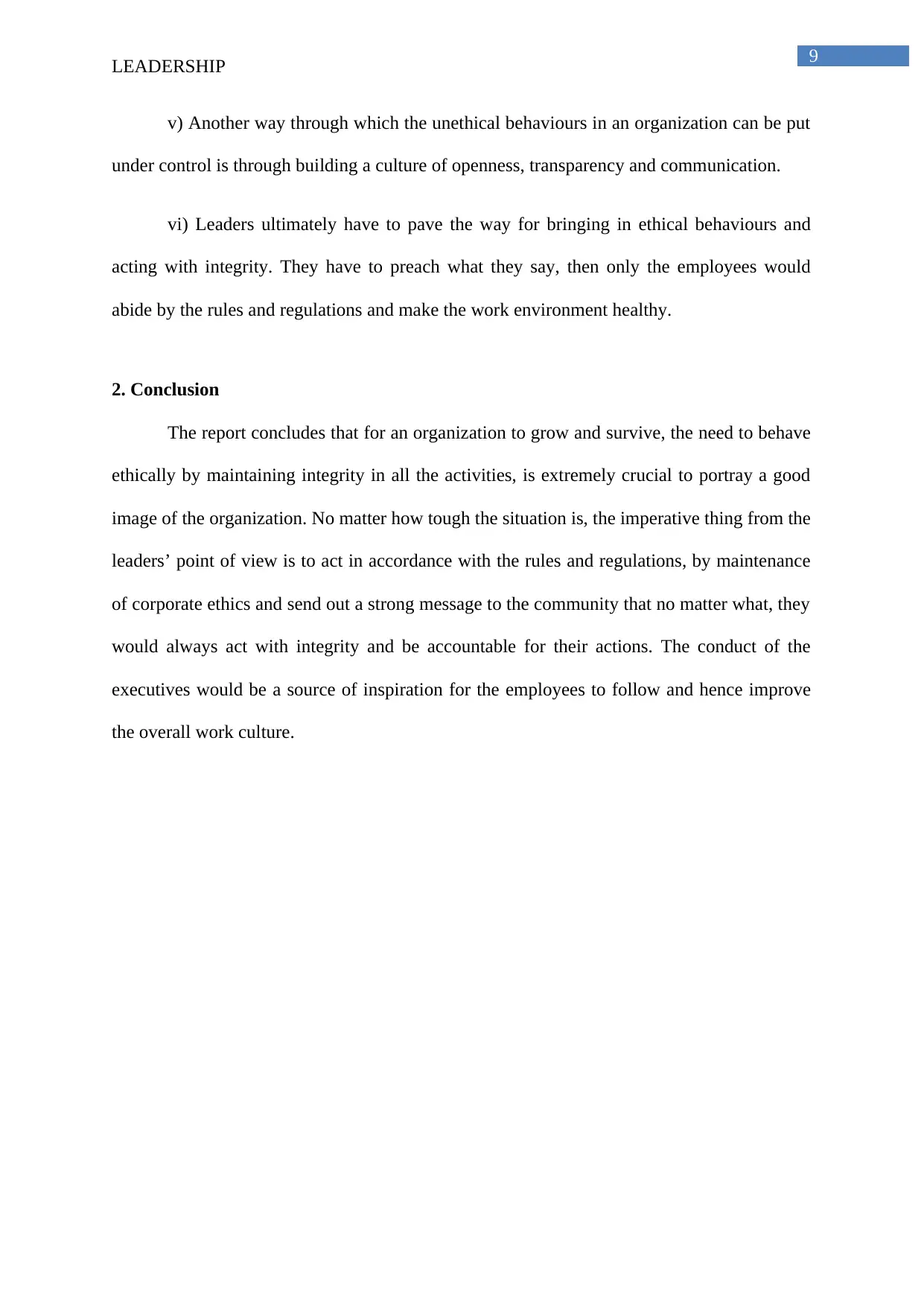
9
LEADERSHIP
v) Another way through which the unethical behaviours in an organization can be put
under control is through building a culture of openness, transparency and communication.
vi) Leaders ultimately have to pave the way for bringing in ethical behaviours and
acting with integrity. They have to preach what they say, then only the employees would
abide by the rules and regulations and make the work environment healthy.
2. Conclusion
The report concludes that for an organization to grow and survive, the need to behave
ethically by maintaining integrity in all the activities, is extremely crucial to portray a good
image of the organization. No matter how tough the situation is, the imperative thing from the
leaders’ point of view is to act in accordance with the rules and regulations, by maintenance
of corporate ethics and send out a strong message to the community that no matter what, they
would always act with integrity and be accountable for their actions. The conduct of the
executives would be a source of inspiration for the employees to follow and hence improve
the overall work culture.
LEADERSHIP
v) Another way through which the unethical behaviours in an organization can be put
under control is through building a culture of openness, transparency and communication.
vi) Leaders ultimately have to pave the way for bringing in ethical behaviours and
acting with integrity. They have to preach what they say, then only the employees would
abide by the rules and regulations and make the work environment healthy.
2. Conclusion
The report concludes that for an organization to grow and survive, the need to behave
ethically by maintaining integrity in all the activities, is extremely crucial to portray a good
image of the organization. No matter how tough the situation is, the imperative thing from the
leaders’ point of view is to act in accordance with the rules and regulations, by maintenance
of corporate ethics and send out a strong message to the community that no matter what, they
would always act with integrity and be accountable for their actions. The conduct of the
executives would be a source of inspiration for the employees to follow and hence improve
the overall work culture.
Paraphrase This Document
Need a fresh take? Get an instant paraphrase of this document with our AI Paraphraser
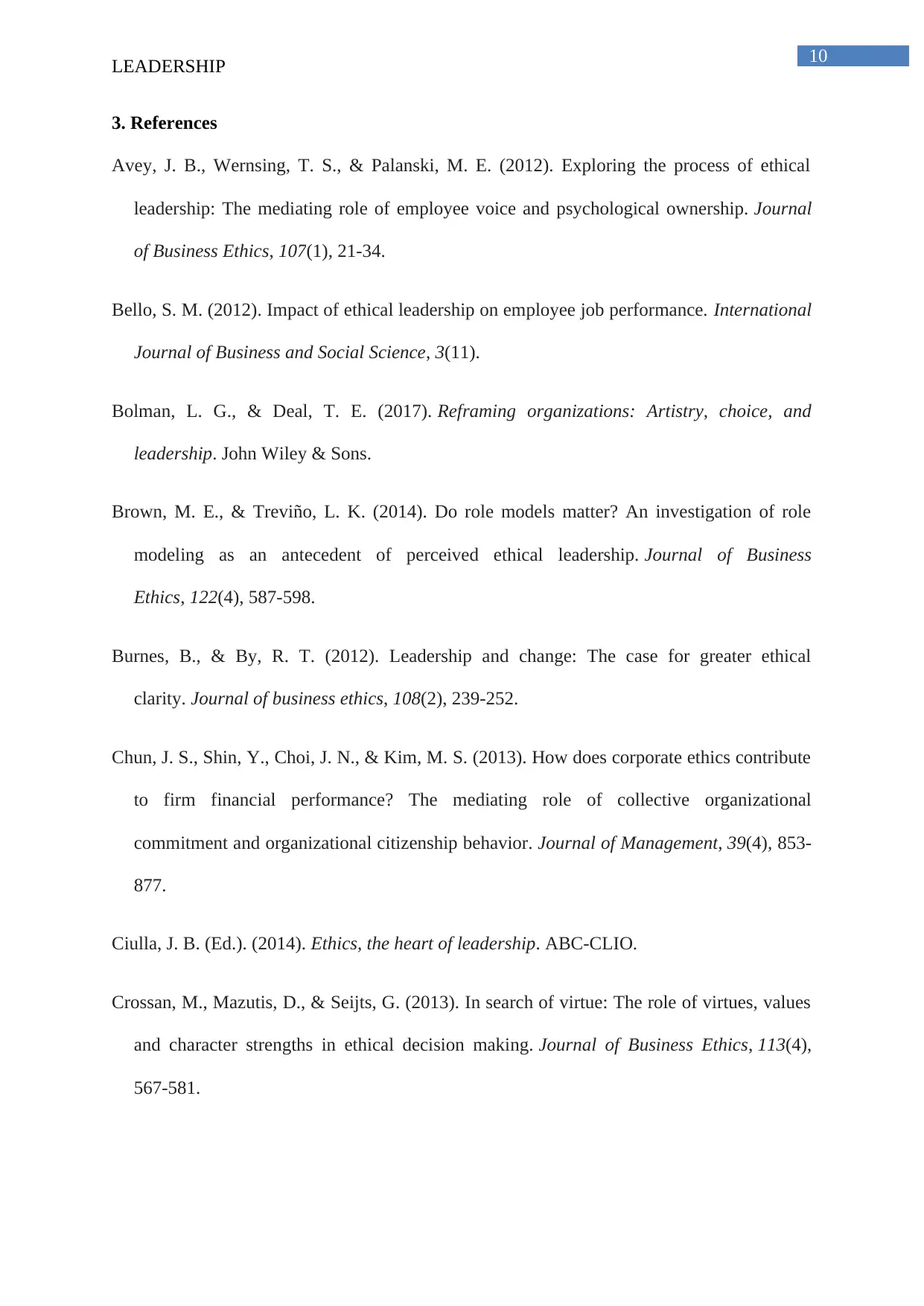
10
LEADERSHIP
3. References
Avey, J. B., Wernsing, T. S., & Palanski, M. E. (2012). Exploring the process of ethical
leadership: The mediating role of employee voice and psychological ownership. Journal
of Business Ethics, 107(1), 21-34.
Bello, S. M. (2012). Impact of ethical leadership on employee job performance. International
Journal of Business and Social Science, 3(11).
Bolman, L. G., & Deal, T. E. (2017). Reframing organizations: Artistry, choice, and
leadership. John Wiley & Sons.
Brown, M. E., & Treviño, L. K. (2014). Do role models matter? An investigation of role
modeling as an antecedent of perceived ethical leadership. Journal of Business
Ethics, 122(4), 587-598.
Burnes, B., & By, R. T. (2012). Leadership and change: The case for greater ethical
clarity. Journal of business ethics, 108(2), 239-252.
Chun, J. S., Shin, Y., Choi, J. N., & Kim, M. S. (2013). How does corporate ethics contribute
to firm financial performance? The mediating role of collective organizational
commitment and organizational citizenship behavior. Journal of Management, 39(4), 853-
877.
Ciulla, J. B. (Ed.). (2014). Ethics, the heart of leadership. ABC-CLIO.
Crossan, M., Mazutis, D., & Seijts, G. (2013). In search of virtue: The role of virtues, values
and character strengths in ethical decision making. Journal of Business Ethics, 113(4),
567-581.
LEADERSHIP
3. References
Avey, J. B., Wernsing, T. S., & Palanski, M. E. (2012). Exploring the process of ethical
leadership: The mediating role of employee voice and psychological ownership. Journal
of Business Ethics, 107(1), 21-34.
Bello, S. M. (2012). Impact of ethical leadership on employee job performance. International
Journal of Business and Social Science, 3(11).
Bolman, L. G., & Deal, T. E. (2017). Reframing organizations: Artistry, choice, and
leadership. John Wiley & Sons.
Brown, M. E., & Treviño, L. K. (2014). Do role models matter? An investigation of role
modeling as an antecedent of perceived ethical leadership. Journal of Business
Ethics, 122(4), 587-598.
Burnes, B., & By, R. T. (2012). Leadership and change: The case for greater ethical
clarity. Journal of business ethics, 108(2), 239-252.
Chun, J. S., Shin, Y., Choi, J. N., & Kim, M. S. (2013). How does corporate ethics contribute
to firm financial performance? The mediating role of collective organizational
commitment and organizational citizenship behavior. Journal of Management, 39(4), 853-
877.
Ciulla, J. B. (Ed.). (2014). Ethics, the heart of leadership. ABC-CLIO.
Crossan, M., Mazutis, D., & Seijts, G. (2013). In search of virtue: The role of virtues, values
and character strengths in ethical decision making. Journal of Business Ethics, 113(4),
567-581.
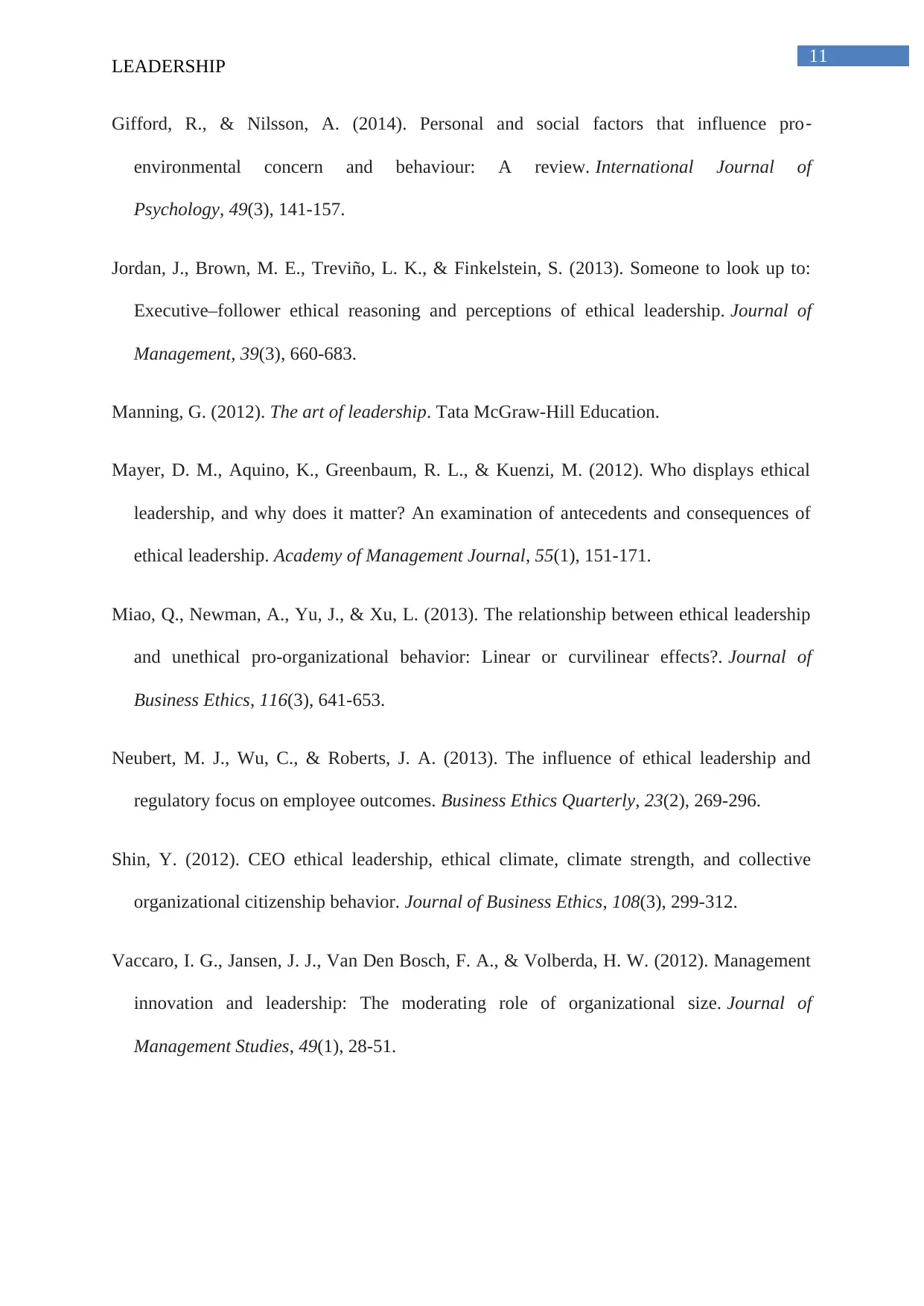
11
LEADERSHIP
Gifford, R., & Nilsson, A. (2014). Personal and social factors that influence pro‐
environmental concern and behaviour: A review. International Journal of
Psychology, 49(3), 141-157.
Jordan, J., Brown, M. E., Treviño, L. K., & Finkelstein, S. (2013). Someone to look up to:
Executive–follower ethical reasoning and perceptions of ethical leadership. Journal of
Management, 39(3), 660-683.
Manning, G. (2012). The art of leadership. Tata McGraw-Hill Education.
Mayer, D. M., Aquino, K., Greenbaum, R. L., & Kuenzi, M. (2012). Who displays ethical
leadership, and why does it matter? An examination of antecedents and consequences of
ethical leadership. Academy of Management Journal, 55(1), 151-171.
Miao, Q., Newman, A., Yu, J., & Xu, L. (2013). The relationship between ethical leadership
and unethical pro-organizational behavior: Linear or curvilinear effects?. Journal of
Business Ethics, 116(3), 641-653.
Neubert, M. J., Wu, C., & Roberts, J. A. (2013). The influence of ethical leadership and
regulatory focus on employee outcomes. Business Ethics Quarterly, 23(2), 269-296.
Shin, Y. (2012). CEO ethical leadership, ethical climate, climate strength, and collective
organizational citizenship behavior. Journal of Business Ethics, 108(3), 299-312.
Vaccaro, I. G., Jansen, J. J., Van Den Bosch, F. A., & Volberda, H. W. (2012). Management
innovation and leadership: The moderating role of organizational size. Journal of
Management Studies, 49(1), 28-51.
LEADERSHIP
Gifford, R., & Nilsson, A. (2014). Personal and social factors that influence pro‐
environmental concern and behaviour: A review. International Journal of
Psychology, 49(3), 141-157.
Jordan, J., Brown, M. E., Treviño, L. K., & Finkelstein, S. (2013). Someone to look up to:
Executive–follower ethical reasoning and perceptions of ethical leadership. Journal of
Management, 39(3), 660-683.
Manning, G. (2012). The art of leadership. Tata McGraw-Hill Education.
Mayer, D. M., Aquino, K., Greenbaum, R. L., & Kuenzi, M. (2012). Who displays ethical
leadership, and why does it matter? An examination of antecedents and consequences of
ethical leadership. Academy of Management Journal, 55(1), 151-171.
Miao, Q., Newman, A., Yu, J., & Xu, L. (2013). The relationship between ethical leadership
and unethical pro-organizational behavior: Linear or curvilinear effects?. Journal of
Business Ethics, 116(3), 641-653.
Neubert, M. J., Wu, C., & Roberts, J. A. (2013). The influence of ethical leadership and
regulatory focus on employee outcomes. Business Ethics Quarterly, 23(2), 269-296.
Shin, Y. (2012). CEO ethical leadership, ethical climate, climate strength, and collective
organizational citizenship behavior. Journal of Business Ethics, 108(3), 299-312.
Vaccaro, I. G., Jansen, J. J., Van Den Bosch, F. A., & Volberda, H. W. (2012). Management
innovation and leadership: The moderating role of organizational size. Journal of
Management Studies, 49(1), 28-51.
⊘ This is a preview!⊘
Do you want full access?
Subscribe today to unlock all pages.

Trusted by 1+ million students worldwide
1 out of 13
Related Documents
Your All-in-One AI-Powered Toolkit for Academic Success.
+13062052269
info@desklib.com
Available 24*7 on WhatsApp / Email
![[object Object]](/_next/static/media/star-bottom.7253800d.svg)
Unlock your academic potential
Copyright © 2020–2025 A2Z Services. All Rights Reserved. Developed and managed by ZUCOL.





